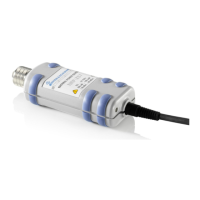Remote Control - Commands R&S NRP-Z5x
1137.0463.12 6.4 E-7
By invoking the CALibration:TEST? command, the power difference in W between the test heater
s
witched on and off is determined and output.
CALibration:TEST:DEViation?
With CALibration:TEST:DEViation?, the power difference in W between the test heater switched on and
off is determined. The relative deviation of the power difference from the reference value stored during
calibration is output.
The CALibration:TEST:DEViation? query internally calls up the CALibration:TEST? and
CALibration:TEST:REFerence? queries. The relative deviation of the first value relative to the reference
value is calculated as follows:
1=
n:TESTCALibratio
iation n:TEST:DEVCALibratio
CALibration:TEST:REFerence?
During the calibration process, the power difference in W between the test heater switched on and off is
determined and stored in the calibration data set. CALibration:TEST:REFerence? yields the value
stored at the time of calibration.
CALibration:ZERO:AUTO[?] OFF | ON | ONCE
The commands CALibration:ZERO:AUTO ON and CALibration:ZERO:AUTO ONCE zeroes the three
measurement paths of the sensor. For this purpose, the test signal must be deactivated or the sensor
disconnected from the signal source. The sensor automatically detects the presence of any significant
power to be measured. This causes zeroing to be aborted and error message NRPERROR_CALZERO
to be output. The CALibration:ZERO:AUTO OFF is ignored. Zeroing takes four seconds at a minimum,
but at least as long as the selected averaging filter needs for settling (only fixed-filter mode).
Repeat zeroing
• during warm-up after switching on or connecting the instrument
• after a substantial variation of the ambient temperature
• after fastening the sensor to an RF connector at high temperature
• after several hours of operation
• when very low-power signals are to be measured, e.g. less than 10
lower measurement limit.
For zeroing switch off the test signal and do not remove the sensor from the signal source.
Apart from kee
ping the thermal balance, this has the advantage that the noise
superimposed on the test signal (e.g. from a broadband amplifier) can be detected on
zeroing and does not impair the measurement result.

